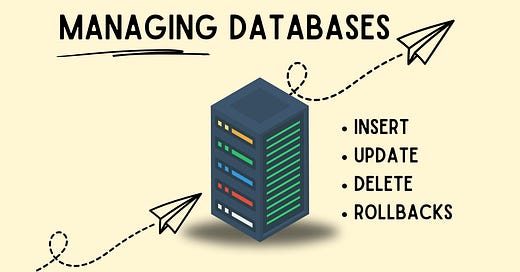The Guide to Inserting, Updating, and Deleting Data in SQL with Python
Discover essential techniques for managing SQL databases with Python, including inserting, updating, and deleting records effectively.
SQL and Python are each powerful on their own, but when you use them together, you get an easy, efficient way to work with databases using just a few lines of code.
Last week, we looked at basic SQL commands in Python—things like SELECT, WHERE, ORDER BY, and LIMIT. This time, we're diving into the essentials of adding, updating, and deleting data in SQL databases using Python, Refer back here.
These skills—knowing how to insert, change, and remove data—are crucial for building apps that interact with data in real-time. As a bonus I also cover data transactions and rollbacks at the end of this article.
Each week, I dive deep into Python and beyond, breaking it down into bite-sized pieces. While everyone else gets just a taste, my premium readers get the whole feast! Don't miss out on the full experience – join us today!
In this article, we'll walk you through these steps to manage SQL databases with Python, using examples, clear code explanations, and analogies to make things easier to understand.
This article is preparing you for the next Project X which we be a SQL based project!
Whether you're working with a small, local database or a larger one, learning to insert, update, and delete records will give you the tools to work with data in a way that’s both dynamic and practical.
If you haven’t subscribed to my premium content yet, I highly encourage you to do so. You gain full access to all of these articles and all the code that comes with them, so you can follow along!
Plus, you’ll get access to so much more, like monthly Python projects, in-depth weekly articles, the '3 Randoms' series, and my complete archive!
This is the third article in our SQL in Python series. Check out the new roadmap for SQL in Python and join premium to access the full archive, learning resources, and more to help you really build a strong foundation!
I spend a lot of my week on these articles, so if you find it valuable, consider joining premium. It really helps me keep going and lets me know you’re getting something out of my work!
If you’re already a premium reader, thank you from the bottom of my heart! You can leave feedback and recommend topics and projects at the bottom of all my articles.
👉 If you get value from this article, please help me out and leave it a ❤️. This helps more people discover this newsletter on Substack! Thank you so much!
In case you want to check out the full SQL in Python series here. Now, let’s jump in and break down what database manipulation, rollbacks, and how you can start using them today!
Keep reading with a 7-day free trial
Subscribe to The Nerd Nook to keep reading this post and get 7 days of free access to the full post archives.





